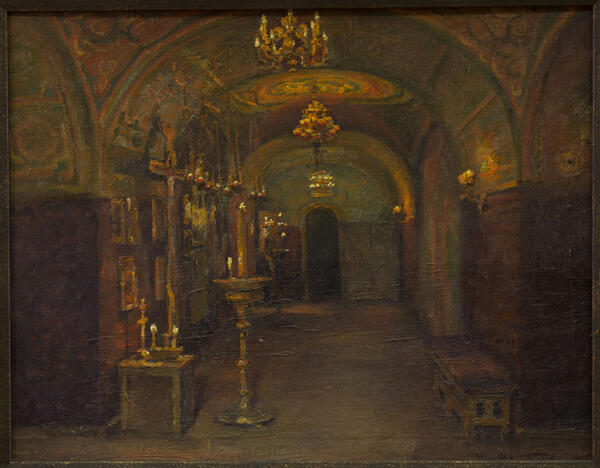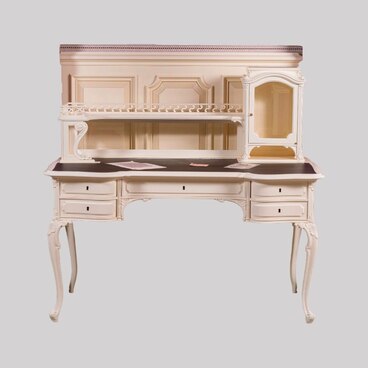“The View of the Cave Church in Our Lady Feodorovskaya Cathedral” is a painting from a series of views of the cathedral and buildings of the Feodorovsky Gorodok in Tsarskoe Selo. It was painted by the artist Mikhail Kirsanov at the request of the imperial court. The series includes landscapes, genre scenes, general views and interiors of the church, created together with the artists Gavriil Gorelov (1880–1966) and Leonid Syrnev (1887–1941). All the works of this unique series are preserved in the collection of the Tsarskoe Selo State Museum and Heritage Site.
Between 1906 and 1913, Mikhail Gerasimovich Kirsanov studied painting under the guidance of Appolinary Vasnetsov, Alexey Korin and Konstantin Korovin at the Moscow Art School. In 1912–1914, the artist was a member of the St. Petersburg Artistic Association. The society was founded on the initiative of students of art schools in order to unite young painters. In 1912, the Association held a major exhibition where 140 artists displayed their works. Kirsanov was among them. On the recommendation of Vasnetsov, the artist was invited as a staff artist to the Ministry of the Imperial Court, where he worked until the February Revolution of 1917.
From 1914, Kirsanov was involved in the work on creating a church in Tsarskoe Selo in honor of the Feodorovskaya icon of the Mother of God. Our Lady Feodorovskaya Cathedral was erected in 1909–1912 for His Imperial Majesty’s Own Cavalry and the Consolidated Infantry Regiment that guarded the Tsar’s residence. The cathedral was a regimental church and a home church for the imperial family, who visited it on holidays and Sundays. It consisted of two parts. The first part was the high and bright upper church, designed to have room for a large number of worshipers, with two side-altars in the name of the Feodorovskaya icon of the Mother of God and in the name of St. Alexis. The second part — the Lower (Cave) Church with the altar in the name of the Venerable Seraphim of Sarov — was a secluded place of prayer for the imperial family.
The completion of the construction of the Feodorovskaya Cathedral coincided with the beginning of the First World War, which was reflected in the works of Mikhail Kirsanov: in his paintings one can notice characteristic symbols of wartime — sisters of mercy and wounded soldiers and officers praying in the church. The painting, presented in the Working Study, depicts a divine service in the Upper Church of the Feodorovskaya Cathedral in the presence of Emperor Nicholas II.
Between 1906 and 1913, Mikhail Gerasimovich Kirsanov studied painting under the guidance of Appolinary Vasnetsov, Alexey Korin and Konstantin Korovin at the Moscow Art School. In 1912–1914, the artist was a member of the St. Petersburg Artistic Association. The society was founded on the initiative of students of art schools in order to unite young painters. In 1912, the Association held a major exhibition where 140 artists displayed their works. Kirsanov was among them. On the recommendation of Vasnetsov, the artist was invited as a staff artist to the Ministry of the Imperial Court, where he worked until the February Revolution of 1917.
From 1914, Kirsanov was involved in the work on creating a church in Tsarskoe Selo in honor of the Feodorovskaya icon of the Mother of God. Our Lady Feodorovskaya Cathedral was erected in 1909–1912 for His Imperial Majesty’s Own Cavalry and the Consolidated Infantry Regiment that guarded the Tsar’s residence. The cathedral was a regimental church and a home church for the imperial family, who visited it on holidays and Sundays. It consisted of two parts. The first part was the high and bright upper church, designed to have room for a large number of worshipers, with two side-altars in the name of the Feodorovskaya icon of the Mother of God and in the name of St. Alexis. The second part — the Lower (Cave) Church with the altar in the name of the Venerable Seraphim of Sarov — was a secluded place of prayer for the imperial family.
The completion of the construction of the Feodorovskaya Cathedral coincided with the beginning of the First World War, which was reflected in the works of Mikhail Kirsanov: in his paintings one can notice characteristic symbols of wartime — sisters of mercy and wounded soldiers and officers praying in the church. The painting, presented in the Working Study, depicts a divine service in the Upper Church of the Feodorovskaya Cathedral in the presence of Emperor Nicholas II.



